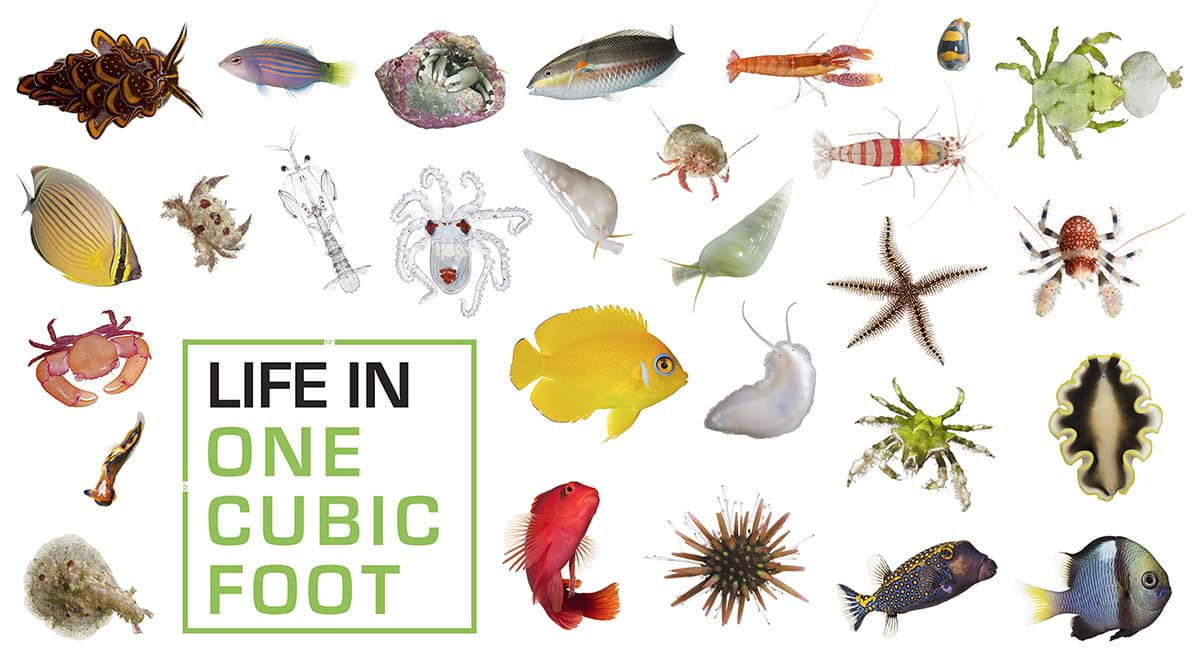“Life in One Cubic Foot” Opens March 18, 2023
A biocube—the tool at the heart of the exhibition—is a 1-by-1-by-1-foot framed cube that organisms from the surrounding environment can enter and pass through. Biocubes featured in the exhibition were placed in environments across the globe to learn what forms of life, both known and unknown, could be found in the cube during a 24-hour period. In addition to exploring life through the exhibition, visitors are also invited to participate in citizen science and uncover the biodiversity in their backyard by creating and monitoring their own biocube.
“Life in One Cubic Foot” explores life from exotic environments, like the coral reefs of French Polynesia and the alien mid-water ocean off the coast of California to the more familiar locales, like New York City’s Central Park. Hundreds of different organisms ranging in size from the head of a pin to the full size of the biocube are featured in the exhibition through collages of photographs, models, interactive elements and exhibition videos.
Biocubes in the exhibition were not only used by scientists to explore what is already known about life on Earth but also to spotlight how much biodiversity remains for aspiring scientists to discover. Scientists estimate that there are more than 1 million species still unknown or unnamed by scientists. Environmental changes, like climate change and other man-made forces, are taking their toll on life around the world, both discovered and unidentified. Global efforts to understand the impact of these changes and answer questions about how to manage the complex dynamics of wildlife and natural resources will be improved as gaps in the tree of life are filled.
After seeing how scientists use the concept of one cubic foot to understand the diversity of life in the field, visitors can learn how biocubes can be used to uncover life in more familiar places. They are invited to build their own biocube and contribute to citizen science by studying and sharing discoveries from their neighborhood habitats.
About the Smithsonian Institute of Traveling Exhibitions
SITES has been sharing the wealth of Smithsonian collections and research programs with millions of people outside Washington, D.C., for more than 65 years. SITES connects Americans to their shared cultural heritage through a wide range of exhibitions about art, science, and history, which are shown wherever people live, work and play. For exhibition description and tour schedules, visit sites.si.edu.
About the Smithsonian National Museum of Natural History
The Smithsonian’s National Museum of Natural History is connecting people everywhere with Earth’s unfolding story. The museum is one of the most visited natural history museums in the world. Opened in 1910, the museum is dedicated to maintaining and preserving the world’s most extensive collection of natural history specimens and human artifacts. For more information, visit naturalhistory.si.edu.
The Fort Worth Museum of Science and History, a distinguished institution established in 1941, is accredited by the American Alliance of Museums and proudly holds Affiliate status with the Smithsonian Institute. Anchored by a diverse and enriching collection spanning science and history, the museum is committed to lifelong learning. Engaging visitors through vibrant programs and exhibits, it interprets the rich tapestry of Texas and the Southwest. The museum’s commitment to education is reflected in its innovative programs, designed to inspire and educate learners of all ages. From interactive workshops to immersive exhibits, the museum provides a dynamic environment for curiosity and intellectual growth. For more information about educational programs, exhibits, and events, visit www.fwmuseum.org.
###

